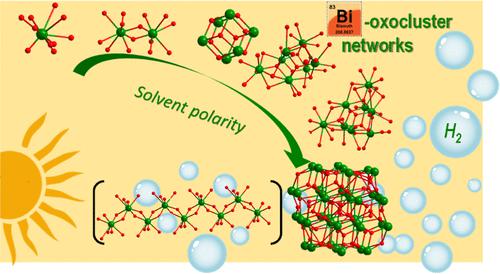当前位置:
X-MOL 学术
›
ACS Appl. Mater. Interfaces
›
论文详情
Our official English website, www.x-mol.net, welcomes your feedback! (Note: you will need to create a separate account there.)
Bismuth-Polyoxocation Coordination Networks: Controlling Nuclearity and Dimension-Dependent Photocatalysis
ACS Applied Materials & Interfaces ( IF 8.3 ) Pub Date : 2023-03-28 , DOI: 10.1021/acsami.3c01172 Mehran Amiri 1 , Alice Lulich 1 , Nan-Chieh Chiu 1 , Samuel Wolff 1 , Dylan B Fast 1 , William F Stickle 2 , Kyriakos C Stylianou 1 , May Nyman 1
ACS Applied Materials & Interfaces ( IF 8.3 ) Pub Date : 2023-03-28 , DOI: 10.1021/acsami.3c01172 Mehran Amiri 1 , Alice Lulich 1 , Nan-Chieh Chiu 1 , Samuel Wolff 1 , Dylan B Fast 1 , William F Stickle 2 , Kyriakos C Stylianou 1 , May Nyman 1
Affiliation

|
Bismuth-oxocluster nodes for metal–organic frameworks (MOFs) and coordination networks/polymers are less prolific than other families featuring zinc, zirconium, titanium, lanthanides, etc. However, Bi3+ is non-toxic, it readily forms polyoxocations, and its oxides are exploited in photocatalysis. This family of compounds provides opportunity in medicinal and energy applications. Here, we show that Bi node nuclearity depends on solvent polarity, leading to a family of Bix-sulfonate/carboxylate coordination networks with x = 1–38. Larger nuclearity-node networks were obtained from polar and strongly coordinating solvents, and we attribute the solvent’s ability to stabilize larger species in solution. The strong role of the solvent and the lesser role of the linker in defining node topologies differ from other MOF syntheses, and this is due to the Bi3+ intrinsic lone pair that leads to weak node–linker interactions. We describe this family by single-crystal X-ray diffraction (eleven structures), obtained in pure forms and high yields. Ditopic linkers include NDS (1,5-naphthalenedisulfonate), DDBS (2,2′-[biphenyl-4,4′-diylchethane-2,1-diyl] dibenzenesulphonate), and NH2-benzendicarboxylate (BDC). While the BDC and NDS linkers yield more open-framework topologies that resemble those obtained by carboxylate linkers, topologies with DDBS linkers appear to be in part driven by association between DDBS molecules. An in situ small-angle X-ray scattering study of Bi38-DDBS reveals stepwise formation, including Bi38-assembly, pre-organization in solution, followed by crystallization, confirming the less important role of the linker. We demonstrate photocatalytic hydrogen (H2) generation with select members of the synthesized materials without the benefit of a co-catalyst. Band gap determination from X-ray photoelectron spectroscopy (XPS) and UV–vis data suggest the DDBS linker effectively absorbs in the visible range with ligand-to-Bi-node charge transfer. In addition, materials containing more Bi (larger Bi38-nodes or Bi6 inorganic chains) exhibit strong UV absorption, also contributing to effective photocatalysis by a different mechanism. All tested materials became black with extensive UV–vis exposure, and XPS, transmission electron microscopy, and X-ray scattering of the black Bi38-framework suggest that Bi0 is formed in situ, without phase segregation. This evolution leads to enhanced photocatalytic performance, perhaps due to increased light absorption.
中文翻译:

Bismuth-Polyoxocation 配位网络:控制核度和尺寸依赖性光催化
用于金属有机骨架 (MOF) 和配位网络/聚合物的铋氧团簇节点比其他以锌、锆、钛、镧系元素等为特征的家族少。但是,Bi 3+ 是无毒的,它很容易形成多氧离子,并且它的氧化物被用于光催化。该化合物家族为医药和能源应用提供了机会。在这里,我们表明 Bi 节点的核度取决于溶剂极性,从而导致具有x的 Bi x -磺酸盐/羧酸盐配位网络家族= 1–38。较大的核节点网络是从极性和强配位溶剂中获得的,我们认为溶剂具有稳定溶液中较大物质的能力。溶剂在定义节点拓扑结构中的重要作用和连接体的次要作用不同于其他 MOF 合成,这是由于 Bi 3+固有孤对导致弱节点-连接体相互作用。我们通过以纯形式和高产率获得的单晶 X 射线衍射(十一种结构)来描述该家族。双位连接体包括 NDS(1,5-萘二磺酸盐)、DDBS(2,2'-[联苯-4,4'-二基甲烷-2,1-二基]二苯磺酸盐)和 NH 2-苯二甲酸酯 (BDC)。虽然 BDC 和 NDS 链接器产生更多类似于羧酸盐链接器获得的开放框架拓扑结构,但具有 DDBS 链接器的拓扑结构似乎部分是由 DDBS 分子之间的关联驱动的。Bi 38 -DDBS的原位小角度 X 射线散射研究揭示了逐步形成,包括 Bi 38 -组装,溶液中的预组织,然后是结晶,证实了接头的次要作用。我们展示了光催化氢 (H 2) 在没有助催化剂的情况下与合成材料的选择成员一起生成。X 射线光电子能谱 (XPS) 和 UV-vis 数据的带隙测定表明,DDBS 连接基在可见光范围内有效吸收,具有配体到双节点的电荷转移。此外,含有更多 Bi(更大的 Bi 38节点或 Bi 6无机链)的材料表现出强烈的紫外线吸收,也通过不同的机制有助于有效的光催化。所有测试的材料在大量的紫外线-可见光照射下都变成黑色,XPS、透射电子显微镜和黑色 Bi 38框架的 X 射线散射表明 Bi 0原位形成,无相分离。这种演变导致光催化性能增强,可能是由于光吸收增加。
更新日期:2023-03-28
中文翻译:

Bismuth-Polyoxocation 配位网络:控制核度和尺寸依赖性光催化
用于金属有机骨架 (MOF) 和配位网络/聚合物的铋氧团簇节点比其他以锌、锆、钛、镧系元素等为特征的家族少。但是,Bi 3+ 是无毒的,它很容易形成多氧离子,并且它的氧化物被用于光催化。该化合物家族为医药和能源应用提供了机会。在这里,我们表明 Bi 节点的核度取决于溶剂极性,从而导致具有x的 Bi x -磺酸盐/羧酸盐配位网络家族= 1–38。较大的核节点网络是从极性和强配位溶剂中获得的,我们认为溶剂具有稳定溶液中较大物质的能力。溶剂在定义节点拓扑结构中的重要作用和连接体的次要作用不同于其他 MOF 合成,这是由于 Bi 3+固有孤对导致弱节点-连接体相互作用。我们通过以纯形式和高产率获得的单晶 X 射线衍射(十一种结构)来描述该家族。双位连接体包括 NDS(1,5-萘二磺酸盐)、DDBS(2,2'-[联苯-4,4'-二基甲烷-2,1-二基]二苯磺酸盐)和 NH 2-苯二甲酸酯 (BDC)。虽然 BDC 和 NDS 链接器产生更多类似于羧酸盐链接器获得的开放框架拓扑结构,但具有 DDBS 链接器的拓扑结构似乎部分是由 DDBS 分子之间的关联驱动的。Bi 38 -DDBS的原位小角度 X 射线散射研究揭示了逐步形成,包括 Bi 38 -组装,溶液中的预组织,然后是结晶,证实了接头的次要作用。我们展示了光催化氢 (H 2) 在没有助催化剂的情况下与合成材料的选择成员一起生成。X 射线光电子能谱 (XPS) 和 UV-vis 数据的带隙测定表明,DDBS 连接基在可见光范围内有效吸收,具有配体到双节点的电荷转移。此外,含有更多 Bi(更大的 Bi 38节点或 Bi 6无机链)的材料表现出强烈的紫外线吸收,也通过不同的机制有助于有效的光催化。所有测试的材料在大量的紫外线-可见光照射下都变成黑色,XPS、透射电子显微镜和黑色 Bi 38框架的 X 射线散射表明 Bi 0原位形成,无相分离。这种演变导致光催化性能增强,可能是由于光吸收增加。






































 京公网安备 11010802027423号
京公网安备 11010802027423号